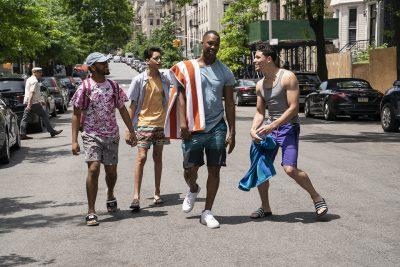After a year of pandemic-induced delays, the anticipated film “In the Heights” will premiere in theaters and on HBO Max on June 11 — revitalized with new twists and turns to reflect today’s time.

The film — adapted from the multiple Tony-award-winning Broadway musical written by Lin-Manuel Miranda — is a summer snapshot of the close-knit immigrant community in the Washington Heights neighborhood in New York City.
The tear-jerking, feel-good story follows irresistibly endearing characters through their hopes, dreams and challenges as they navigate the desire to leave a legacy and make their community proud.
Equipped with a catchy and vibrant hip-hop Latin score, the musical played on Broadway from 2008 to 2011. Miranda composed the music and lyrics for the original show and starred as the main character Usnavi, while Quaira Alegría Hudes wrote the script.
Long after its Broadway debut — and more than a decade of work towards the new film —the story is back with a cinematic twist, new and returning cast members, and soundtrack and plot changes to enhance the story for a 2021 movie.
Warner Bros hosted a roundtable for college student journalists for the film May 24 with eight of the stars along with Hudes and Miranda to talk about the film’s debut and the universality of the story.
Hudes, who wrote the screenplay for the film, initially joined the “In The Heights” team when she was in her 20s, “young and new” to her craft, she said.
She said that on a personal note, she felt ready and excited to “re-explore the story that [she feels] does still matter” after she had done her own growth as an artist.
“I was hungry to take another crack at it, definitely,” Hudes said.
After the Broadway musical closed, Miranda created the sensation “Hamilton.” But when asked what it’s like to come back to the “In the Heights” story now for the film, Miranda said the story’s creators never really left it.
“Once you make a musical together, it’s not unlike being a co-parent,” Miranda said. “We continued to make decisions on the life of the show.”
Hudes said some of the changes in the film were made to give more attention to stories like Nina’s — played in the film by Leslie Grace — such as cutting Nina’s mother, Camila, from the screenplay.
“‘In the Heights’ has always been a tapestry. When I had joined I was like, to me the lead character is the community,” Hudes said. “We knew we would have to eliminate some elements to let the ones that remain in the tapestry [have] room to breathe.”
Miranda also discussed bringing Nina’s previously off-stage struggle with school as a first-generation Stanford University student to life in the film, which he said involved drawing from personal experience.
Miranda said he felt closest to Nina in terms of his lived experience, seeing the sacrifice his parents made to pay for college and acknowledging that parents like his and Nina’s “came from somewhere else, and made a way where there was no way.”
He said he felt it was a story others could relate to as well.
“So much of Nina’s story is about navigating and acknowledging the sacrifice that your parents are going through, even beyond the practicalities of just paying for school,” he said. “We really worked on that, me from the music side and [Hudes] from the dramaturgical side, to bring out that nuance.”
Jimmy Smits — who plays Nina’s father, Kevin Rosario — said his personal experience as the first in his extended family to go to college informed his portrayal of Nina’s dad in the film.
Smits said he hopes the movie relates to universal themes that are more ready to be received than during the Broadway debut.
“Coming through this pandemic and having to reckon with not only health issues, but a lot of social issues, whether it’s LGBTQ or immigration or BLM,” he said. “I hope that those universal themes are going to resonate with audiences in the delivery system of a musical which is all about joy and a very specific lens.”
Gregory Diaz, a 16-year-old singer, dancer and actor who plays Usnavi’s cousin Sonny in the film, said he came into the film a huge fan of the franchise, and said he focused on growing the character and “making [the role] my own.”
Diaz also described the film’s new take on the character as a “dreamer,” a young immigrant without documentation protected under the Deferred Action on Childhood Arrivals or DACA program.
While playing this character, he said he wanted to focus on portraying dreamers positively, as well as a message of belonging.
“When something like him being a dreamer was added, as an actor that’s something else to tackle,” Diaz said, “and not wanting that to be something seen as a negative, because it isn’t, but something that can be portrayed and the messages that come along with it as a positive.”
Dascha Polanco — playing Cuca, a salon employee written for the film — said the experience of acting in a salon scene was both “familiar” and “enriching.” She said playing the role involved drawing inspiration from the women in her community that raised her and her family, and was a place they could just be themselves.
“It’s part of our culture to have the intimate moments with your salon [staff],” Polanco said. “It’s a therapy session, it’s one of the pillars in our community … It’s a safe place for us to feel at home.”
Daphne Rubin-Vega — who plays Daniela, the salon owner in the film — said it is “always gratifying” to bring immigrant stories to light.
“It allows us to maybe think of that and perceive that differently and find an incredibly beautiful commonality within,” Rubin-Vega said.
The film also included new special effects and unique elements to bring the story to life.
Grace, who plays Nina, said filming “When the Sun Goes Down” was “incredible” and challenging, full of technical elements and elaborate choreography to create an illusion.
“We put our heart and soul into it because we knew that it was going to be such a special moment,” Grace said. “It’s a magical … illusion, but we knew we were part of something really special and we just really wanted to give our best and nail it.”
Corey Hawkins, who plays Nina’s love interest, Benny, said the scene was about “them sort of bending the world to what they want it to be” as they danced on the side of the building, which he said is a great representation of the film’s message.
“It’s so powerful that that becomes the last moment we see,” Hawkins said. “If they want to defy gravity and change the rules then they can do that, and so can you.”
Though the movie includes changes, it also includes some special elements from the original.
Olga Merediz, who won a Tony Award for her role in the original Broadway production of “In the Heights,” returned to her role as Abuela Claudia. She said returning to the story at a time in her life when she had more growth allowed her to add “more maturity and depth” to the character.
“The camera and the movies, it’s so internal and it’s so personal, you’ve got to be honest, because the camera picks up everything,” she said. “I felt much more of a connection with her, with Abuela Claudia.”
She also felt a connection to the “strong women” in her family who, like Abuela Claudia, were the “rock pillars” in their communities and loved ones’ lives, she said.
Melissa Barrera, who plays Usnavi’s love interest Vanessa in the film, pointed to how the film’s major focus is dreams, and how every immigrant or child of an immigrant is a type of dreamer, in the “broad sense” of the word.
Polanco said there’s “not enough” of stories like this that elevate Latinx, Black and brown voices. She said the excitement and enthusiasm around “In the Heights” illustrates how necessary these stories are.
“It goes to show this can work. These stories do work,” she said. “There’s a yearn for it, and a need and necessity so it’s so necessary right now. So the question is, when’s the next?”














